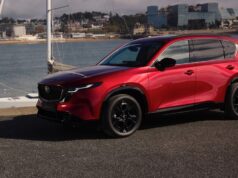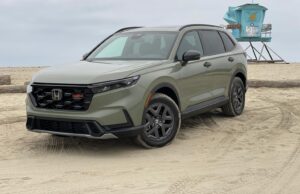
For years automakers have claimed that small cars equal small profits, which explains their focus on bigger more profitable vehicles. Well now that large vehicles are out, automakers are trying to go small without killing their profits. Ford is hoping that its new “global” Focus will deliver double digit percentage profit improvements compared to the current US-spec Focus.
The next-generation Focus is going to finally share more parts with the much better Euro-spec Focus. According to Ford the current Focus that we have here only shares about 20 percent of its parts with the European Focus, eventually that percentage is going to increase to 90 percent. By sharing more parts globally Ford is hoping to increase the profits of vehicles built on the new glbal C-car platform.
Ford has announced that the automaker plans on bringing six of its European models to North America by 2012. The first two vehicles will be the new Fiesta and Focus in 2010.
Related Stories:
Ford Seeks the Best Quality in the Industry With the New Fiesta and Focus
PRESS RELEASE:
Ford’s Global Product Plan to Drive Increased Small Car Profits; New Team to Bolster Vehicle Connectivity
– Ford’s upcoming new Focus in North America and other small car derivatives built off a new global C-car platform will deliver a double-digit percentage profit improvement compared with the company’s current North American Focus – “One Ford” global product plan to increase parts commonality between the European and North American Focus from approximately 20 percent today to 90 percent in the coming years – Ford forming new customer connectivity team to accelerate its leadership in smart in-car technology, such as Ford SYNC(TM), SIRIUS Travel Link(TM), Ford Work Solutions(TM) and HD radio
TRAVERSE CITY, Mich., Aug 13, 2008 — Ford Motor Company expects the quality, fuel efficiency, smart technologies and shared global nature of its upcoming new Focus small car in North America and other derivatives built off a new global C-car platform to deliver a double-digit percentage profit improvement compared with today’s North American Focus.
In addition, Ford is forming a new customer connectivity team to accelerate its leadership in vehicle smart technology solutions that are increasingly important to small car customers, including Ford SYNC, SIRIUS Travel Link and Ford Work Solutions and HD radio.
Mark Fields, Ford’s president of The Americas, announced the latest details about the company’s accelerated transformation and plan to introduce several new fuel-efficient small cars during a speech at the Center for Automotive Research’s annual Management Briefing Seminars in Traverse City, Mich.
“We at Ford see this year’s consumer shift to smaller vehicles as an opportunity and one that Ford is uniquely positioned to answer using the strength of our European small car lineup and our fast-moving global product plan,” said Mark Fields, executive vice president and president, The Americas. “We plan to answer the call with dynamic, fun-to-drive small cars – and we intend to make them profitably.”
Ford is significantly accelerating small car development by leveraging global platforms that will deliver major savings through increased economies of scale.
Ford announced last month that it plans to bring six small vehicles from the company’s acclaimed European lineup to North America by 2012 as part of a strategy to leverage its leadership in B- and C-car sized vehicles in Europe in North America and around the world. As part of this product plan, Ford will introduce the new Fiesta small car in North America in early 2010 and the new Ford Focus small car later in 2010.
Ford also is speeding the introduction of its fuel-efficient EcoBoost engine technology and four-cylinder engines, boosting hybrid production and converting three existing truck and SUV plants for small car production, with the first conversion beginning this December.
Ford already has shifted the balance of its North American product portfolio from a 70 percent emphasis on trucks and large SUVs in 2004, to nearly 60 percent cars and crossovers today. By the end of 2010, two-thirds of the company’s spending will be on cars and CUVs. Much of that investment is aimed squarely at small cars – particularly the C-segment in which Focus competes today.
Small Cars: A Solid Foundation
Today, small cars like the Focus account for one of every four vehicles sold around the world. By 2012, that number is expected to increase more than 20 percent to 6 million vehicles in North America and 25 million units worldwide.
Ford will address the growing demand for small cars by marshaling its global strength. Within five years, the company plans to build nearly 2 million units a year worldwide off its global C-platform and 1 million units off its global B-car platform.
Ford is building off a strong base. Ford introduced the Focus in the U.S. in 1999, and the popular small car is fast approaching the 2 million unit milestone. Year-to-date, Focus sales are up 26 percent, compared with industry-wide small car growth of approximately 9 percent. Exclusive in-vehicle technology like Ford SYNC and up to 35 mpg fuel economy have fueled the Focus’s strong performance.
Leveraging Ford’s Global Scale
Ford will build a profitable car business in North America by engineering and sourcing cars globally. For example, Ford is reducing complexity and streamlining the vehicle order process to make it far easier for customers to find the vehicles they want on dealer lots. Dealers will benefit from reduced inventory age, lowered floor plan costs, simplified vehicle orders and quicker days to turn. The company gains engineering efficiencies, reduces build combinations, cuts prototype expenses, further drives quality improvements and creates volume opportunities.
“We’ve reduced the number of orderable combinations in North America – including series, packages and options – by 90 percent for the Ford brand alone in the 2008-2009 model years,” Fields said. “If you look at the C-segment, Focus will provide approximately 150 combinations by the 2010 model year – more than a 95 percent reduction versus the 2008 model year.”
New Ford Team to Accelerate In-Vehicle Connectivity
Ford also today announced it is dedicating a new team to further enhance the driving experience for customers and accelerate the company’s connectivity leadership.
This new 40-person customer connectivity group will leverage Ford’s industry-leading portfolio of on-board technologies – including SYNC, SIRIUS Satellite radio, SIRIUS Travel Link, Ford Works Solutions and HD radio – to deliver information and services from the Internet in a way that maximizes convenience and limits distractions.
The team will build on partnerships the company has established with world-class technology service providers to ensure customers have seamless access to best-in-world data and information services – affordably.
Ford has appointed Doug VanDagens, 50, to lead the team. He joined Ford in 1986 and most recently has been leading Ford’s electronic product development and business operations, which already has been working to bring industry-leading features such as SYNC and Travel Link to market.
In-vehicle connectivity is particularly important to small car customers, who want to downsize their vehicle but not their smart technologies or creature comforts.
“We’re making stylish, high-quality products to appeal a new breed of buyers,” Fields said. “Our small cars need to be more ambitious vehicles than ever, delivering style, perceived quality and appealing to lifestyle, not life stage.”
One of the most influential groups of customers shopping the small car segment today – and considering possibilities for tomorrow – is the Millennials, the growing population of 14- to 29-year-olds. Approximately 11,000 of these tech-savvy consumers reach driving age every day. By 2010, this group will represent 28 percent of the driving population.








